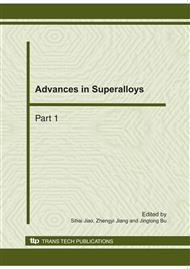p.1126
p.1132
p.1138
p.1142
p.1147
p.1154
p.1159
p.1163
p.1170
Tribological Performance of Ionic Liquids Bearing Hydroxyl Groups as Lubricants in the Aluminum-on-Steel Contacts
Abstract:
A series of room temperature ionic liquids bearing hydroxyl groups, namely 1-(3’-hydroxyl-n-propyl)-3-alkylimidazolium tetrafluoroborate or hexafluorophosphate, were prepared and characterized. Their typical physical properties were also determined. The tribological test results show that these ionic liquids possess better friction-reducing and anti-wear ability for aluminum-on-steel system than lubricant X-1P. The friction coefficients of them are little higher than that of the nonfunctionlized ionic liquid LP308, while they possess better anti-wear abilities than the latter, which may ascribe to the chemical activity of hydroxyl group. Both the anions and the side substituted alkyl chains attached to the imidazolium cations affect the tribological performance of the lubricants. The SEM, EDS and XPS analysis of the worn surfaces show that complicated tribo-chemical reactions were involved in the sliding process. The boundary films composed of fluorides, nitrogen oxide, BN, and FePO4 were generated on the rubbing aluminum surfaces, which contribute to effectively decreasing the friction and wear of the contacts.
Info:
Periodical:
Pages:
1147-1153
Citation:
Online since:
October 2010
Authors:
Price:
Сopyright:
© 2011 Trans Tech Publications Ltd. All Rights Reserved
Share:
Citation:


